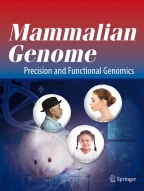Abstract
Frequency distribution and allele size in 20 canine microsatellite loci were analyzed in 33 flat-coated retrievers, 32 dachshunds, 10 red foxes, and 10 Arctic foxes. Overall, the major difference between the two dog breeds was the relative allele frequencies rather than the size ranges of alleles at the individual locus. The average heterozygosity within the two dog breeds was not significantly different. Since the average heterozygosity at several polymorphic loci is a relative measure of heterogeneity within the population, analysis of heterozygosity within microsatellite loci is suggested as a measure for the diversity of populations. Eighty percent (16 of 20) of the canine microsatellite primer pairs amplified corresponding loci in the two fox species. This reflects a very high sequence conservation within the Canidae family relative to findings in, for instance, the Muridae family. This indicates that it will be possible to utilize the well-characterized fox karyotype instead of the dog karyotype as a step towards physical mapping of the dog genome. Analysis of exclusion power and probabilities of genetic identity between unrelated animals by use of the seven most informative loci demonstrated that it will be possible to assemble a panel of microsatellite loci that is effective for parentage analysis in all breeds.
Similar content being viewed by others
References
Bowcock, A.M., Ruiz-Linares, A., Tomfohrde, J., Minch, E., Kidd, J.R., Cavalli-Sforza, L.L. (1994) High resolution of human evolutionary trees with polymorphic microsatellites. Nature 368, 455–457.
Fredholm, M., Winterø, A.K., Christensen, K., Kristensen, B., Nielsen, P.B., Davies, W., Archibald, A. (1993). Characterization of 24 porcine (dA-dC)n-(dT-dG)n microsatellites: genotyping of unrelated animals from four different breeds and linkage studies. Mamm. Genome 4, 187–192.
Hamada, H., Kakunaga, T. (1982). Potential Z-DNA forming sequences are highly dispersed in the human genome. Nature 298, 396–398.
Hamada, H., Petrino, M.G., Kakunaga, T. (1982). A novel repeated element with Z-DNA-forming potential is widely found in evolutionarily diverse eukaryotic genomes. Proc. Natl. Acad. Sci. USA 79, 6465–6469.
Holmes, N.G., Mellersh, C.S., Humphreys, S.J., Binns, M.M., Holliman, A., Curtis, R., Sampson, J. (1993). Isolation and characterization of microsatellites from the canine genome. Anim. Genet. 24, 289–292.
Hudson, T.J., Engelstein, M., Lee, M.K., Ho, E.C., Rubenfield, M.J., Adams, C.P., Housman, D.E., Dracopoli, N.C. (1992). Isolation and chromosomal assigment of 100 highly informative human simple sequence repeat polymorphisms. Genomics, 13, 622–629.
Jamieson, A. (1966). The distribution of transferrin genes in cattle. Heredity 21, 191–218.
Kondo, Y., Mori, M., Kuramoto, T., Yamada, J., Beckmann, J.S., Simon-Chazottes, D., Montagutelli, X., Guénet, J.L., Serikawa, T. (1993). DNA segments mapped by reciprocal use of microsatellite primers between mouse and rat. Mamm. Genome 4, 571–576.
Koorey, D.J., Bishop, G.A., McCaughan, G.W. (1993) Allele non-amplification: a source of confusion in linkage studies employing microsatellite polymorphisms. Hum. Mol. Genet. 2, 289–291.
Levan, G., Szpirer, J., Szpirer, C., Klinga, K., Hanson, C., Islam, M.Q. (1991). The gene map of the Norway rat (Rattus norvegicus) and comparative mapping with mouse and man. Genomics 10, 699–718.
Litt, M., Luty, J.A. (1989) A hypervariable microsatellite revealed by in vitro amplification of a dinucleotide repeat within the cardiac muscle actin gene. Am. J. Hum. Genet. 44, 397–401.
Maniatis, T., Fritch, E.F., Sambrook, J. (1982). Molecular cloning. Cold Spring Harbor, N.Y.: Cold Spring Harbor Laboratory Press.
Miller, S.A., Dykes, D.D., Polesky, H.F. (1988). A simple salting out procedure for extracting DNA from human nucleated cells. Nucleic Acids Res. 16, 1215–1215.
Moore, S.S., Sargeant, L.L., King, T.J., Mattick J.S., Georges, M., Hetzel, D.J.S. (1991). The conservation of dinucleotide microsatellites among mammalian genomes allows the use of heterologous PCR primer pairs in closely related species. Genomics 10, 654–660.
Ostrander, E.A., Sprague, G.F., Rine, J. (1993). Identification and characterization of dinucleotide repeat (CA)n markers for genetic mapping in dog. Genomics 16, 207–213.
Sanger, F., Nicklen, S., Coulson, A.R. (1977) DNA sequencing with chain-terminating inhibitors. Proc. Natl. Acad. Sci. USA 74, 5463–5467.
Serikawa, T., Kuramoto, T., Hilbert, P., Mori, M., Yamada, J., Dubay, C.J., Lindpainter, K., Ganten, D., Guènet, J.-L., Lathrop, G.M., Beckmann, J.S. (1992). Rat gene mapping using PCR-analyzed microsatellites. Genetics 131, 701–721.
Stallings, R.L., Ford, A.F., Nelson, D., Torney, D.C., Hildebrand, C.E., Moyzis, R.K. (1991). Evolution and distribution of (GT)n repetitive sequences in mammalian genomes. Genomics 10, 807–815.
Wall, W.J., Williamson, R., Petrou, M., Papaioannou, D., Parkin, B.H. (1993). Variation of short tandem repeats within and between populations. Hum. Mol. Genet. 2, 1023–1029.
Wayne, R.K. (1993). Molecular evolution of the dog family. Trends Genet. 9, 218–224.
Wayne, R.K., Jenks, S.M. (1991). Mitochondrial DNA analysis implying extensive hybridization of the endangered red wolf Canis rufus. Nature 351, 565–568.
Wayne, R.K., O'Brien, S.J. (1987). Chromosomal evolution of the canidae. Cytogenet. Cell Genet. 44, 123–133.
Weber, J.L. (1990). Informativeness of human (dC-dA)n-(dG-dT)n polymorphisms. Genomics 7, 524–530.
Weber, J.L., May, P.E. (1989). Abundant class of human DNA polymorphisms which can be typed using the polymerase chain reaction. Am. J. Hum. Genet. 44, 388–396.
Winterø, A.K., Fredholm, M., Thomsen, P.D. (1992). Variable (dG-dT)n-(dC-dA)n sequences in the porcine genome. Genomics 12, 281–288.
Author information
Authors and Affiliations
Rights and permissions
About this article
Cite this article
Fredholm, M., Winterø, A.K. Variation of short tandem repeats within and between species belonging to the Canidae family. Mammalian Genome 6, 11–18 (1995). https://doi.org/10.1007/BF00350887
Received:
Accepted:
Issue Date:
DOI: https://doi.org/10.1007/BF00350887
